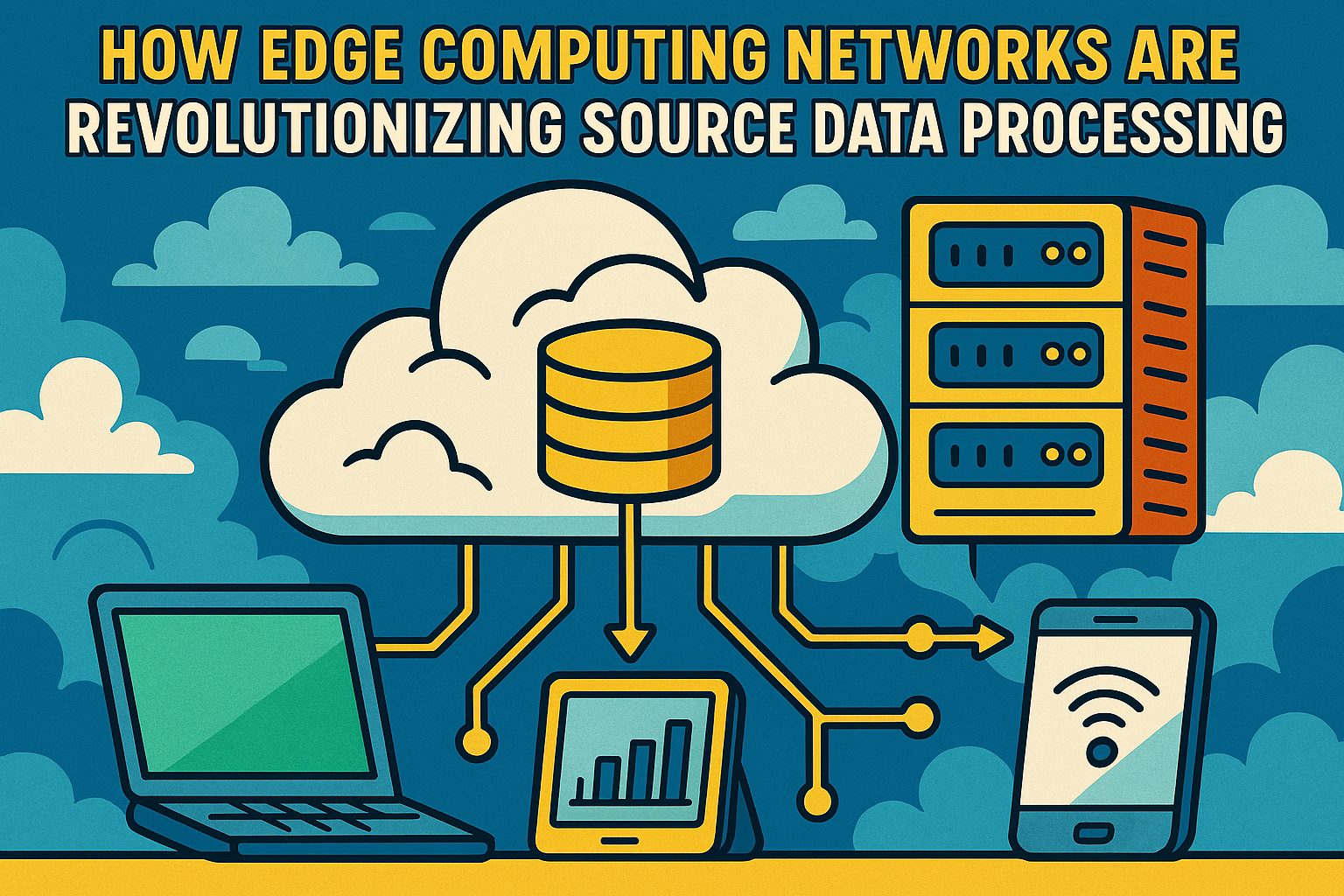Edge computing has changed the way we think about data processing as well as network topology. This revolution has been observed for several years now, and the most astonishing thing is that this technology brings computational power to the actual site where data originates, rather than remote cloud servers. This approach reduces latency, accelerates response times, and enables real-time decision-making in a way that was implausible even ten years ago. From self-driving automobiles to industrial factory systems, applications of every variety depend upon edge computing to function efficiently, and even online platforms like bizbet download have been impacted by how they load their algorithms for data processing to provide faster, more responsive experiences.
The traditional method of shipping all the data to the central cloud servers to process simply isn’t fast enough for applications today that require responses in split seconds. Edge computing addresses this limitation by moving processing closer to the edge of the network — closer to where data is generated and decisions need to be made. This distributed paradigm has far-reaching implications that go well beyond the simple gains in performance; it’s transforming the very foundations of how we design and deploy digital infrastructure.
“If you look back over the history of computing, it started as mainframes or terminals. As PCs or work stations became prevalent, computing moved to the edge and we had applications that took advantage of edge computing, and the CPU and processing power at the edge. Cloud computing brought things back to the center.” – noted Peter Levine (venture capital investor).

Understanding Edge Computing Architecture and Infrastructure
Edge computing represents a shift from the central to distributed models of processing. Edge computing architecture demarcates the manner in which this technology positions computing resources at optimal locations within the network architecture.
The principal building blocks of edge computing infrastructure are several integrated components:
- Local data processing edge nodes with minimal latency
- Data movement gateways for edge devices to core systems
- Localized compute and storage resources of micro data centers
- Workload orchestration platforms that direct workloads across the distributed edge resources
- Security frameworks that protect data and applications across the distributed network
What’s so interesting about edge computing architecture is the way it balances local processing capabilities with centralized management and orchestration. Edge nodes can process independently when bandwidth is low across the network, yet they orchestrate with central systems when bandwidth is plentiful. This hybrid design offers the resilience and flexibility that solely cloud or on-premises implementations can’t deliver.
Physical infrastructure requirements for edge computing are very different from those required for typical data center implementations. Edge sites must operate in multiple environments — factory floors to remote cell towers — with limited room, power, and air. That has driven innovation in highly dense, highly efficient computing hardware designed for edge deployment.
Network Topology and Communication Protocols
Edge computing networks utilize sophisticated communication protocols to manage data transfer between distributed nodes. The network topology is typically hierarchical, where local edge devices offer data to proximal processing nodes, and these proximity nodes exchange communications with regional data centers and ultimately central cloud infrastructure when such a need arises.
Latency issues govern a lot of the architectural design in edge networks. Coping with operations that require rapid response locally, lower-priority operations can be batched and sent to more powerful central systems. This hierarchical approach optimizes performance and resource utilization across the network.
Network availability is particularly critical to edge computing implementations. Unlike centralized facilities where redundancy can be built into one site, edge networks must provide availability of service across numerous dispersed sites. This has led to innovative solutions to fault tolerance and failover schemes.
Applications of Real-Time Processing Across Industries
Edge computing has been embraced across industries, each having specific needs for real-time computation and low-latency response. Edge computing in manufacturing facilities is used to monitor equipment performance and predict maintenance needs before failure. Local data processing from sensors allows for critical decisions to be made in milliseconds rather than seconds or minutes consumed by cloud processing.
Autonomous vehicles are likely the most demanding application of edge computing technology. These vehicles must process vast volumes of sensor data and make split-second decisions in terms of navigation, object avoidance, and safety features. The latency to send data to distant servers would make autonomous driving unsafe and impractical.
Healthcare solutions have embraced edge computing to enable patient monitoring and emergency response systems. Medical devices can now do local processing of vital signs and trigger automated alarms when dangerous conditions are detected. The power of local processing can be lifesaving in a situation where network connectivity is weak or in any situation where seconds matter.
Smart city infrastructure relies greatly on edge computing in order to manage traffic systems, track air quality, and manage emergency response. Traffic lights can have their timing manipulated based on real-time traffic patterns, while environmental sensors can react in real-time to spillover pollution or other hazardous situations.
Retail utilizes edge computing for inventory management, customer analytics, and tailoring shopping. Point of sale systems are capable of processing transactions locally even in the case of network unavailability, while analytics in-store can provide real-time insights into customer behavior and preferences.
Edge Computing Industry Applications and Benefits
| Industry | Primary Use Cases | Response Time Requirements | Key Benefits |
| Manufacturing | Equipment monitoring, predictive maintenance | Milliseconds | Reduced downtime, cost savings |
| Automotive | Autonomous driving, navigation, safety systems | Split-second | Enhanced safety, real-time decisions |
| Healthcare | Patient monitoring, emergency response | Seconds matter | Life-saving alerts, continuous monitoring |
| Smart Cities | Traffic management, air quality monitoring | Real-time | Optimized infrastructure, emergency response |
| Retail | Inventory management, customer analytics | Instant | Improved customer experience, local processing |
Platform Integration and Mobile Applications
The integration of edge computing with mobile platforms has created new possibilities for responsive apps and services. The mobile devices themselves serve as edge computing nodes, where information is processed locally before resolving what information needs to be passed to distant servers. This way, bandwidth consumption is minimized as well as the responsiveness of applications is improved.
Game websites have been at the forefront when it comes to edge computing technology, using distributed processing in order to reduce lag and improve customers’ experiences. The technology allows for real-time multiplayer games and cloud gaming services that are not possible with traditional centralized systems. Online gambling websites like bizbet have also implemented similar edge computing methodologies in order to offer instant odds updates and real-time betting experiences that respond in real time to changing market conditions.
Mobile application development has come to utilize the capabilities of edge computing features. Applications can now perform heavy processing locally with the provision to remain connected to the cloud for backup and synchronization. This hybrid strategy provides the benefits of both worlds — local responsiveness along with cloud scale performance.
Development Tools and Frameworks
The edge computing software development ecosystem has matured significantly over the last few years. Developers now have domain-specific frameworks and tools for distributed edge applications. They abstract away the programming complexity of workloads on multiple edge nodes and provide familiar development abstractions to the users.
Container Technology and Orchestration
Container technology has assumed greater importance for edge computing deployments. Containers provide a consistent runtime environment on a wide range of edge hardware platforms, facilitating easier application deployment and administration. Orchestration frameworks designed for edge environments will be able to automatically distribute and scale containerized apps based on on-site resources available and processing demands.
The technological transformation of the economy continues to drive innovation in edge computing solutions, as detailed in recent technological transformation research, highlighting how distributed computing architectures are reshaping business operations across various sectors.
Key development tools and frameworks include:
- Edge-specific container orchestration platforms that manage distributed workloads across heterogeneous hardware
- Lightweight runtime environments optimized for resource-constrained edge devices
- Cross-platform development frameworks that enable consistent application behavior across diverse edge nodes
- Debugging and monitoring tools designed for distributed edge environments
- API gateways that facilitate communication between edge nodes and central systems
- Code deployment pipelines that automate application distribution to multiple edge locations

Security Implementation and Management
Security is uniquely challenging in edge computing environments. Unlike in centralized environments where the security controls are concentrated in a single location, edge networks must implement security controls across numerous geographically dispersed nodes with diverse physical security settings and network behavior patterns.
Data encryption is also made more complex in edge systems where processing must occur on potentially sensitive data. Homomorphic encryption and secure multi-party computation are approaches that enable edge nodes to process encrypted data without compromising security. Such approaches offer real-time processing with high standards of safeguarding data.
Identity and access systems must take into account the spread-out nature of edge computing. Decisions about authentication and authorization are often required locally since network connectivity with central identity providers is intermittent. To meet this requirement has led to new approaches to distributed identity management and zero-trust security frameworks.
Physical security needs are particularly applicable to edge deployments. Edge hardware is typically deployed in environments with minimal physical security controls, and tamper detection and secure boot mechanisms become critical to ensure system integrity. Hardware-assured security features like trusted platform modules are becoming routine additions to edge computing infrastructure.
Monitoring network security in edge environments requires distributed solutions that can identify and respond to threats in multiple locations. Traditional centralized security monitoring solutions may not have adequate visibility into edge network traffic and potential security intrusions.
Resource Management and Optimization
Resource allocation in edge computing platforms requires sophisticated algorithms that balance processing workloads across dispersed nodes while considering heterogeneous hardware capabilities and network environments. Unlike cloud settings, where resources are relatively homogeneous, edge networks usually consist of heterogeneous hardware platforms with different performance profiles.
Edge computing load balancing methods must consider both processing capability and network connectivity when redistributing the workloads. A system with great processing capacity but poor network connectivity might not always be optimal placement for specific tasks. Dynamic load balancing algorithms continuously analyze these two parameters in an attempt to optimize system performance.
Power consumption is a key consideration in the majority of edge computing deployments. Edge nodes operate in environments where there is not a lot of power or power expense is a critical concern. This restraint has promoted the advancement of low-power compute structures and intelligent power management techniques.
Storage management at the edge environments is particularly challenging. Edge nodes typically do not have much local storage, so they need wiser data retention and archival policies. High-usage data must be cached locally for responsiveness and less significant data can be shipped off to central store systems.
Caching techniques play a large role in determining edge computing performance. More intelligent caching techniques can predict what data will be needed locally and pre-install it into edge storage. This type of foresight reduces latency and improves user experience without over-transferring data.
Edge Computing Resource Management Challenges and Solutions
| Challenge | Traditional Approach | Edge Computing Solution | Impact |
| Load Balancing | Centralized algorithms | Dynamic distributed algorithms | Optimized performance across heterogeneous nodes |
| Power Management | Abundant power assumed | Low-power architectures | Reduced operational costs |
| Storage Limitations | Centralized storage | Intelligent caching and data retention | Improved responsiveness |
| Processing Capacity | Homogeneous resources | Heterogeneous hardware optimization | Better resource utilization |
| Network Connectivity | Reliable connections | Intermittent connectivity handling | Enhanced resilience |
Economic Impact and Business Value
Edge computing also has significant economic implications for the organizations that are embracing such technologies. Reduced bandwidth needs can lead to considerable cost reductions, particularly for applications generating voluminous data. Rather than transferring raw sensor data to cloud servers, edge processing can make important conclusions locally and transmit only the results.
Operational efficiency gains through edge computing can be dramatic. Industrial plants using edge computing for predictive maintenance experience reductions in unplanned downtime and maintenance costs. Having the ability to identify and fix problems prior to equipment failure brings clear economic benefit.
Such distributed edge computing architecture can also improve business resilience. Organizations depend less on connectivity to core data centers and can function even in network outage scenarios. Such improved resilience results in reduced business risk and improved customer satisfaction.
Edge computing makes new business models possible that are impossible with central architectures. Real-time analysis and immediate response create opportunities for service offerings that require real-time processing and return. These new capabilities can create competitive differentiation and revenue opportunities.
Investment in edge computing hardware is a question of tight planning and evaluation. Organizations must balance the expense of distributed hardware deployment against the benefits of increased performance and reduced bandwidth utilization. The return on investment generally depends on the needs of individual use cases and available infrastructure capabilities.
Future Technologies and Integration
Artificial intelligence and machine learning are becoming more integrated into edge computing systems. Edge AI makes it possible to make decisions in real time with local data processing without any requirement for cloud-based AI services connection. This aspect is particularly beneficial for applications like autonomous vehicles and industrial automation systems.
5G networks are facilitating the use of edge computing with high-bandwidth, low-latency connectivity needed for future-generation edge applications. 5G and edge computing enable new application scenarios like augmented reality applications and real-time video analytics not supported by previous-generation networks.
Quantum computing is bound to move into edge environments eventually, although it isn’t easy to do today. Quantum edge computing would provide unprecedented processing for certain types of problems, particularly in cryptography and optimization applications.
The Internet of Things (IoT) will continue to drive the use of edge computing as more and more devices generate data that is enhanced by local processing. Smart sensors that can perform local analytics and machine learning inference are the future of IoT devices.
Edge computing is being standardized, which will improve interoperability and ease deployment. Industry organizations are working together to establish common interfaces and protocols that will make it easier to build and deploy edge computing solutions onto diverse hardware platforms.
The Distributed Future of Computing Infrastructure
Edge computing is a paradigm shift in the manner in which computing systems are created and deployed. The technology addresses the real-world limitations of centralized cloud computing while opening up new possibilities for real-time, smart applications. With the technology still developing, edge computing is becoming more and more the standard for applications that require real-time processing and low-latency feedback.
The economic and technical benefits of edge computing are driving adoption across numerous industries. Organizations that implement edge computing strategies successfully experience outstanding competitive gain through improved operational efficiency and new service opportunities. The technology is particularly well-suited for applications in which near real-time response is critical to safety, quality, or usability.
The combination of edge computing with emerging technologies like 5G, AI, and IoT will create new applications and use cases that are only beginning to be understood. The distributed processing model introduced by edge computing will be the foundational element of the future digital infrastructure, driving everything from smart cities to autonomous systems.
